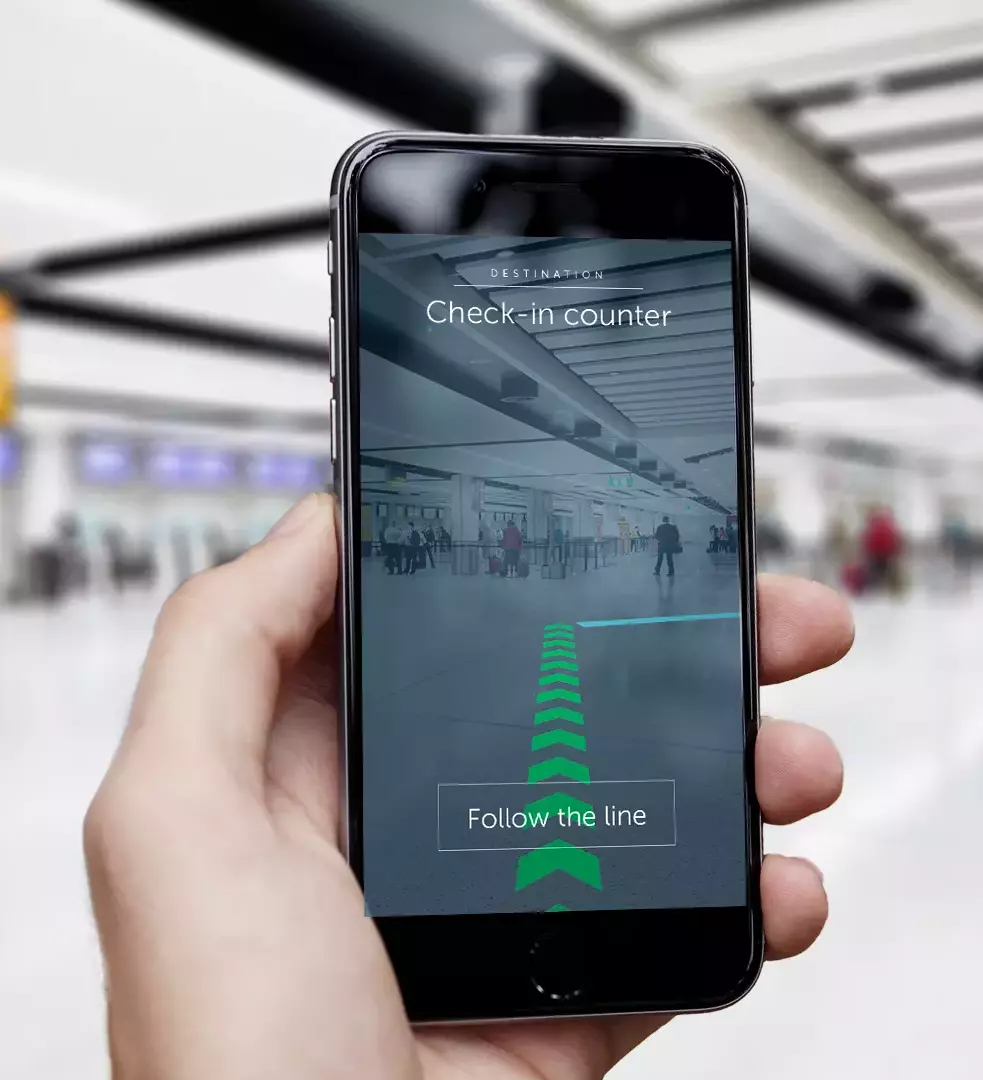Know where your going
It’s easy to get lost in a new place we haven’t been to before.
No one enjoys being disoriented, especially when the clock is ticking. Ironically, when we are in a new place, we have the least amount of time to waste and the keenest desire to minimise hassle. We’re often restricted by time, money and even parking meters. When we travel to unfamiliar places we want to immerse ourselves in the new experience and not worry how to get there.


According to a recent study
Over three-quarters of smartphone owners regularly use navigation apps
Apps such as Google Maps enable users to navigate a route to a street, business or home we are unfamiliar with and get there right on time. Navigational apps make travelling so much easier with turn-by-turn audio directions, allowing us to focus on driving or walking.
What about indoor wayfinding?
If GPS is so great, why are we still getting lost in malls, galleries, airports, campuses and hospitals?
The first reason is GPS doesn’t work indoors. The second is indoor environments are inherently complex. Google Maps for example document fixed structures such as streets, roads, houses and buildings in an outdoor environment. They collect and combine satellite imagery with aerial photography, street maps and 360-degree street views and offer users location intelligence on the go unencumbered by concrete.

According to psychologist Christoph Hölscher indoor environments involve a complex set of cognitive processes:
”You have to ‘locate’ yourself, you have to ‘locate’ objects, you have to make inferences, you have to make connections, you have to find ‘a road’ from A to B… all of those are metaphors but the underlying structure is quite similar; you have to make decisions, you have to memorise something, you have to bring to bear some kind of expertise.
According to the Digital Signage Federation
We are entering a second wave of 3D wayfinding thanks to both augmented reality and virtual reality technologies.
Augmented reality wayfinding apps provide consumers with an efficient way to find their way around. When users holding their mobile devices in the air in front of them, the app overlays dynamic directions and captions to lead you where you want to go.
Locating oneself
What is Wayfinding?
Wayfinding involves locating oneself within an environment or finding your way between two points. It’s particularly critical in complex environments, such as healthcare facilities, college campuses, airports and shopping centres. As sites become more intricate, aids such as maps, directions and symbols to help with destination guidance are invaluable.
To date, the primary tools for wayfinding have been asking other humans for directions or signs and interactive maps that point people in the right direction. While these are helpful they are not the most efficient means to direct a person from the entrance of a hospital to a ward or from one display to another at a museum. Advancements in bluetooth beacons and phone hardware are creating AR wayfinding experiences that reduce the time and cognitive workload of human wayfinding.


New wayfinding system
What is Augmented Reality Wayfinding?
Augmented Reality (AR) Wayfinding is an innovation that superimposes digital information onto a real-world view, in real-time on a connected mobile device. It helps people find their way in complex, built environments.
Implementing an Augmented Reality-enabled Wayfinding system involves studying user experience and requirements in environments such as hospitals, airports, universities and shopping centres. Research shows AR significantly reduces the time and cognition load of finding your way in new environments.
AR Wayfinding can guide customers through an environment with directional prompts overlaid onto the real-world setting. It can also suggest the most efficient route. The AR system is so precise it can guide users to a distant gate in a busy airport or even a specific bed in a vast medical facility.
A person can walk into a completely unfamiliar environment with no information about a particular precinct. Using an app on their connected device, they can take an interactive tour or find their way to wherever they need to go.
AR increases the effectiveness of navigation systems by displaying directions, as well as the length of the trip, possible hazards, alternative routes and any other points of interest along the way.
Beyond improving finding your way around supermarkets, galleries, museums, conferences and more, AR can also improve accessibility for visually impaired users by providing turn-by-turn audio prompts.
AR Wayfinding can also help streamline customer flow in busy commercial environments. Similar to traffic alerts in Google Maps, when there are long queues in built environments, wayfinding can direct visitors into different lines and shorten wait times at airports, stadiums, retail stores and hospitals.
Deploy augmented reality
Airport Wayfinding
London’s Gatwick airport is the largest single runway airport in the world, and the first to deploy augmented reality technology. To date, they’ve installed 2,000 indoor beacons. The beacons provide an indoor navigation system enabling third parties, airlines and the airport itself to develop augmented reality wayfinding tools within their apps.
Travellers can use the system to locate themselves, find their departure gate, as well as amenities, VIP lounges, luggage carousels, exits, information counters, hire car desks and taxi ranks.

AR Enhanced Placemaking
AR enhanced placemaking can maximise the physical, cultural and social identities of a space or location. By sharing information about a site’s history or culture through the line of sight on a connected device in the moment, AR can enhance appreciation of spaces by enabling new and creative interactions with museum and gallery installations. Placemaking can engage users, both local residents and visitors, in new and interactive ways.
For example, viewing a painting in a gallery through a mobile phone can trigger links to audio interviews with the artist, videos of curators discussing the artist’s technique, as well as photos of the artist in his studio, and a timeline of the artist’s life.
Visitors to sites with AR placemaking tools become more aware of their surroundings and gain a stronger understanding of the place’s culture and history.
Deploy augmented reality
Different uses of Augmented Reality for Wayfinding and Placemaking
In-store or location navigation
Mobile AR in-store navigation apps can enhance the shopping experience by enabling customers to search for products, save them to lists and then find them in-store using their smartphones. The technology uses motion tracking, depth perception and area learning to direct customers through stores by overlaying directional prompts onto the real life in-store view.
Landmark overlays and positioning
Wayfinding for pedestrians is challenging when landmarks are hidden by obstructions, tunnels and high-rise buildings. AR-based applications can overlay 3D images of prominent landmarks onto a smartphone’s live camera feed. Users can see invisible landmarks, which can help them orientate themselves and find their own way more easily.
Visualisation and Community Engagement
Through its ability to reimagine how spaces look and can be used, AR can facilitate community feedback and engagement by visualising a proposed development in its planned environment. Bringing to life a development proposal can highlight potential problems such as with shadows onto surrounding houses from high-rise buildings, blocking district views, privacy concerns with windows overlooking back fences and directly into neighbouring windows. Potential use cases include redevelopment projects, public works and new housing constructions.
Museums and Galleries
AR can enhance our understand of art and museum exhibitions by delivering context in the moment. By downloading the relevant app on your smartphone and viewing the display through the app, visitors can access further historical information such as audio recordings, curator commentary, timelines and photographs. Users can view these artefacts at their discretion to enhance their understanding of the installation and its significance within the cultural landscape or natural world.
Networking Events
Emerging applications for AR include marketing, networking and branding. For example, AR apps can enable attendees to scan company logos of business contacts and access company videos, podcasts and websites. This tool makes learning about industry colleagues and researching businesses super easy, enhancing the networking experience. Mobiddiction demonstrated their test AR scanner at the NSW Business Chamber last month. Guests scanned the Mobiddiction logo and accessed a company video instantaneously. Users were stunned at the ease of use and abundance of information available at their fingertips.
As AR in wayfinding technology and hardware continue to develop, its use and infrastructure will increase dramatically and enhance many areas of our lives. From community engagement, to libraries, stadiums, precincts, retail complexes, theatres, museums, university and hospital campuses there are many ways AR can help humans find the products and services they need faster.
Placemaking using AR can enhance our experience of sites, exhibits, displays and environments by linking what we see in the moment with vast collections of textual, audio and visual information available online. Accessing broad contextual resources through our fingertips in our line of sight in this way, will grow our understanding of the present exponentially and change how we learn dramatically.

